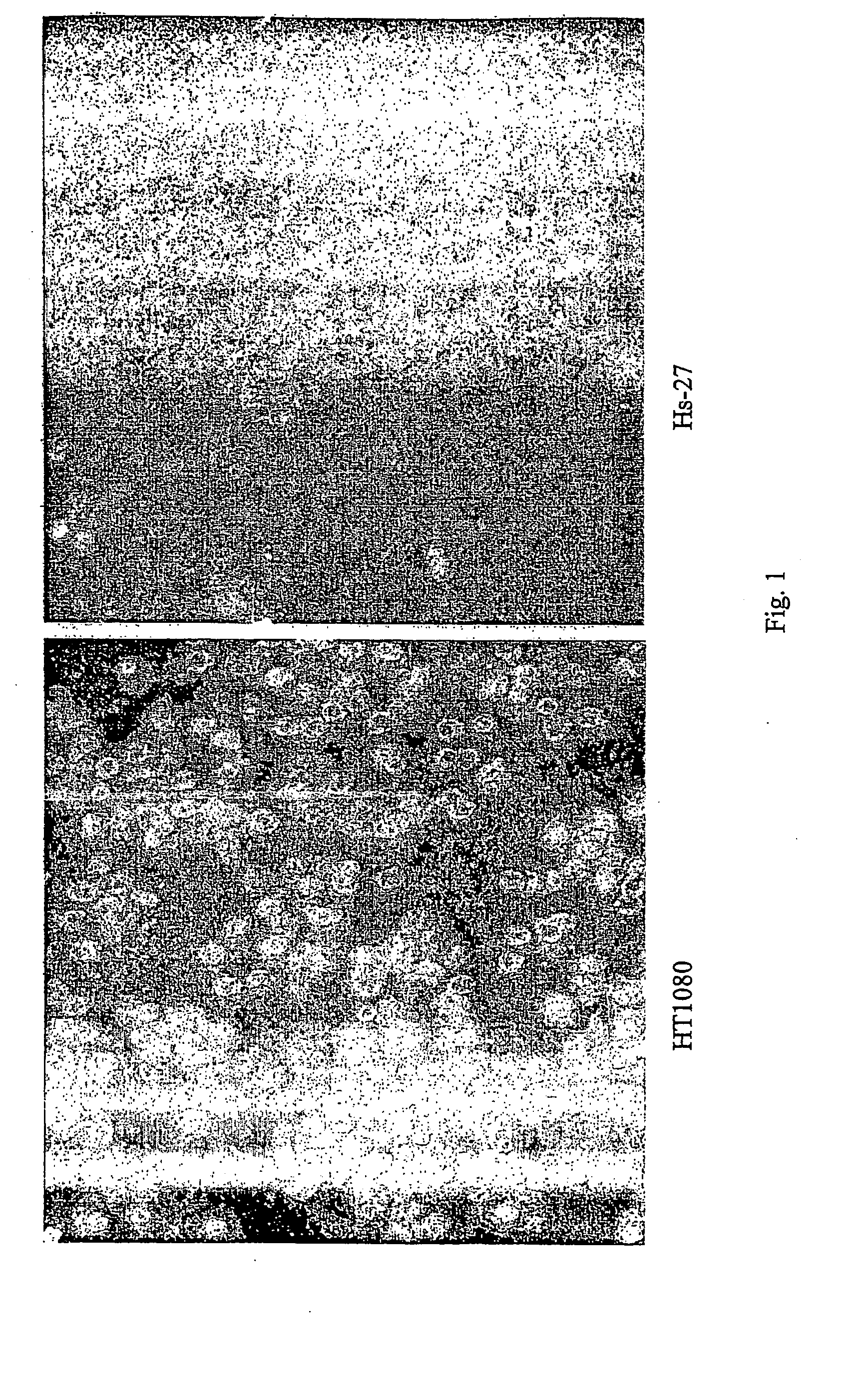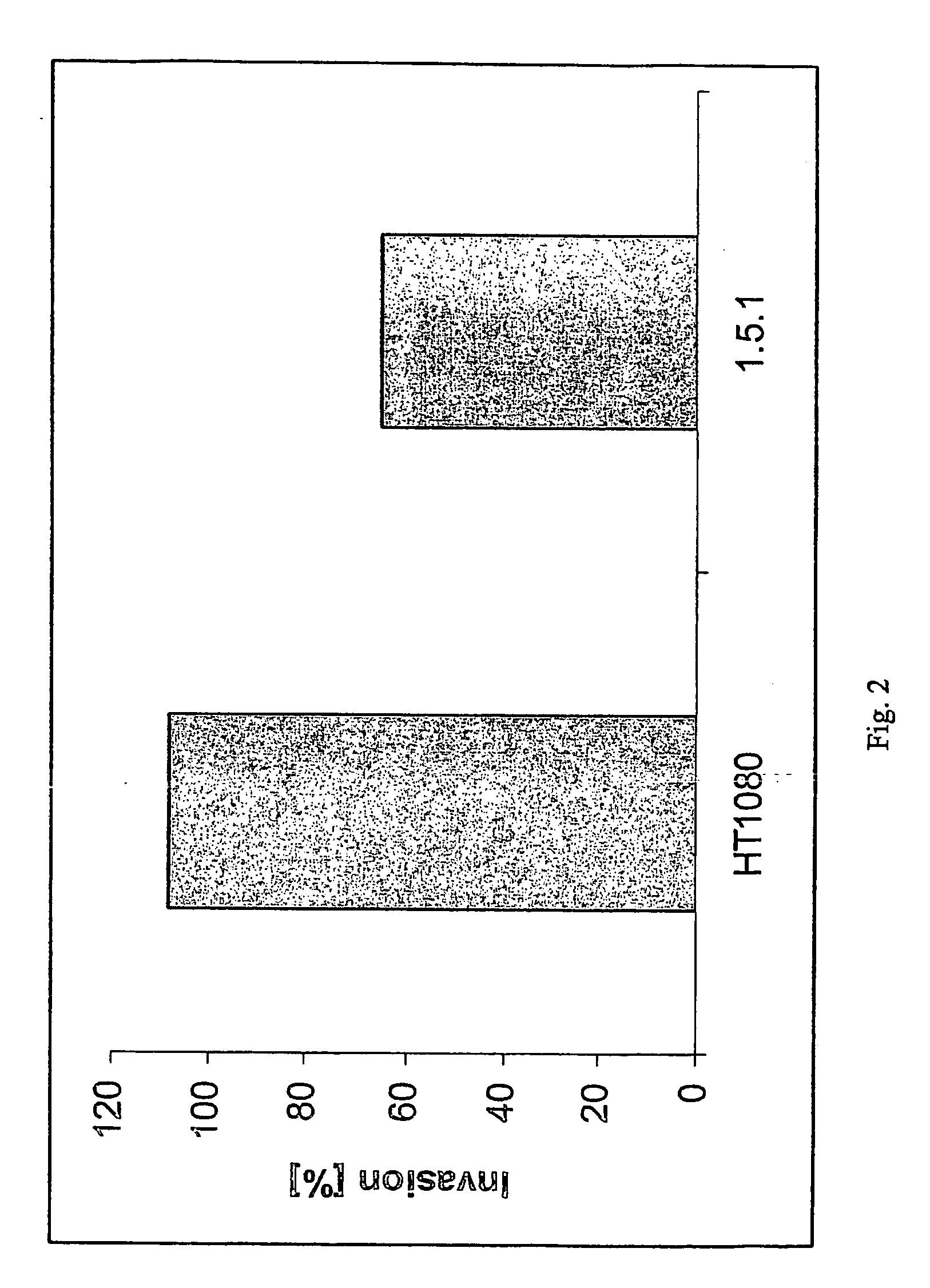Inhibitors of extracellular Hsp90
- Summary
- Abstract
- Description
- Claims
- Application Information
AI Technical Summary
Benefits of technology
Problems solved by technology
Method used
Image
Examples
example 1
Generation of Monoclonal Antibodies (e.g. mAb1.5.1)
[0155] Mice were immunized with either fixed or lysed HT-1080 cells twice over three months. For fixation, confluent (1×107 / 75 cm2 flask) HT-1080 cells were washed once with PBS, then removed with PBS and scraping. Cells were resuspended by pipeting, centrifuged for 5 minutes at 220×g, and fixed with 10 mL of 2% paraformaldehyde for 10 minutes at 4° C. Cells were washed with PBS, then resuspended in 1 ML of PBS. Lysed cells were generated by trypsinizing confluent HT-1080 cells, washing once with PBS, then pelleting for 1 minute at 12000×g. Cells were then lysed in lysis buffer (0.67 Triton-X-100 in 0.33M Tris-HCl, pH 7.5) at room temperature for 5 minutes. Lysate was then centrifuged for 5 minutes at 12000×g. Triton-X-100 was removed by adding the lysate to PD-10 columns and eluting protein with 3.5 mL PBS. Protein was quantitated using Micro-BCA kit (Pierce), and 150 μg / mL / mouse was used for immunization.
[0156] Generation of hyb...
example 2
Construction of an Immune Library
[0158] Two BALB / c mice were each immunized intradermally with 2×107 paraformaldehyde fixed HT-1080 cells (human fibrosarcoma cell line; ATCC, CCL-121). Following the first immunization, the injections were repeated twice in a period of 39 days, the mice sacrificed and the spleens isolated and frozen in liquid nitrogen.
[0159] Total RNA was isolated using the RNeasy Midi Kit (QIAGEN #75142) as described by the manufacturer using half of each spleen preparation. The RNA concentration and purity was determined by a denaturing formaldehyde gel and photometric measurement.
[0160] cDNA was synthesized using 8.9 μg of freshly prepared RNA and 10 pmol of a primer mix IgG1-c, IgG2a-c, IgG2b-c, IgG3-c, VLL-c, VLK-c) using the Superscript™ II Kit (GibcoBRL Life Technologies #18064-014). These primers anneal to the RNA encoding the IgG heavy-chain (VH) genes and the light chain (VL) genes of the kappa and lambda family. VH genes were PCR amplified from 1 μl of ...
example 3
Selection and Screening of scFv (Selection on Fixed Cells)
[0161] Single chain Fv were selected from a phage display library generated from mice immunized with fixed HT-1080 cells. The library was generated using the phage display vector pXP10.
[0162] Phages expressing scFv with high affinity to tumor cells were selected as follows: HT-1080 cells were harvested with 0.05% EDTA, fixed with paraformaldehyde, diluted to 1×107 cells / ml in PBS and immobilized onto wells of a 96 well UV cross-link plate (Corning Costar). The wells of the UV cross-link plate were blocked with 5% Skim Milk Powder (#70166, Fluka) in PBS (MPBS). 1012 cfu (colony forming units) of phage library / 106 cells were pre-blocked for 1 hour at 25° C. with MPBS and subsequently incubated for 1.5 hour at room temperature (RT) with the cells. The wells of the UV cross-link plate were washed six times with PBS+0.05% Tween-20 followed by six washes with PBS. Bound phage were eluted by the addition of 10 mM Glycine pH 2.2, a...
PUM
 Login to View More
Login to View More Abstract
Description
Claims
Application Information
 Login to View More
Login to View More - R&D
- Intellectual Property
- Life Sciences
- Materials
- Tech Scout
- Unparalleled Data Quality
- Higher Quality Content
- 60% Fewer Hallucinations
Browse by: Latest US Patents, China's latest patents, Technical Efficacy Thesaurus, Application Domain, Technology Topic, Popular Technical Reports.
© 2025 PatSnap. All rights reserved.Legal|Privacy policy|Modern Slavery Act Transparency Statement|Sitemap|About US| Contact US: help@patsnap.com



